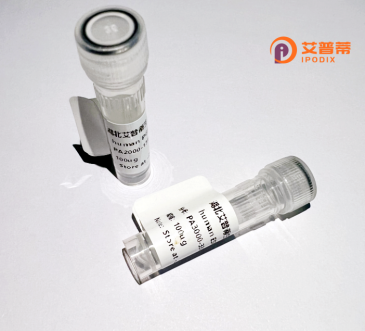
| 纯度 | >90%SDS-PAGE. |
| 种属 | Human |
| 靶点 | SRMS |
| Uniprot No | Q9H3Y6 |
| 内毒素 | < 0.01EU/μg |
| 表达宿主 | E.coli |
| 表达区间 | 1-488aa |
| 活性数据 | MEPFLRRRLA FLSFFWDKIW PAGGEPDHGT PGSLDPNTDP VPTLPAEPCS PFPQLFLALY DFTARCGGEL SVRRGDRLCA LEEGGGYIFA RRLSGQPSAG LVPITHVAKA SPETLSDQPW YFSGVSRTQA QQLLLSPPNE PGAFLIRPSE SSLGGYSLSV RAQAKVCHYR VSMAADGSLY LQKGRLFPGL EELLTYYKAN WKLIQNPLLQ PCMPQKAPRQ DVWERPHSEF ALGRKLGEGY FGEVWEGLWL GSLPVAIKVI KSANMKLTDL AKEIQTLKGL RHERLIRLHA VCSGGEPVYI VTELMRKGNL QAFLGTPEGR ALRLPPLLGF ACQVAEGMSY LEEQRVVHRD LAARNVLVDD GLACKVADFG LARLLKDDIY SPSSSSKIPV KWTAPEAANY RVFSQKSDVW SFGVLLHEVF TYGQCPYEGM TNHETLQQIM RGYRLPRPAA CPAEVYVLML ECWRSSPEER PSFATLREKL HAIHRCHP |
| 分子量 | 54.5 kDa |
| 蛋白标签 | His tag N-Terminus |
| 缓冲液 | PBS, pH7.4, containing 0.01% SKL, 1mM DTT, 5% Trehalose and Proclin300. |
| 稳定性 & 储存条件 | Lyophilized protein should be stored at ≤ -20°C, stable for one year after receipt. Reconstituted protein solution can be stored at 2-8°C for 2-7 days. Aliquots of reconstituted samples are stable at ≤ -20°C for 3 months. |
| 复溶 | Always centrifuge tubes before opening.Do not mix by vortex or pipetting. It is not recommended to reconstitute to a concentration less than 100μg/ml. Dissolve the lyophilized protein in distilled water. Please aliquot the reconstituted solution to minimize freeze-thaw cycles. |
以下是3-4条与重组人SRMS(Src-related kinase lacking regulatory and myristylation sites)蛋白相关的文献示例,包含标题、作者及摘要概括:
1. **《Characterization of the SRMS Tyrosine Kinase: A Downstream Effector of EGFR Signaling Pathway》**
*作者:Li et al. (2015)*
摘要:研究通过重组表达人SRMS激酶,分析了其在EGFR信号通路中的作用,发现SRMS可通过磷酸化下游靶蛋白调节细胞增殖和迁移。
2. **《Structural and Functional Analysis of Recombinant Human SRMS Kinase》**
*作者:Park et al. (2018)*
摘要:利用大肠杆菌系统重组表达并纯化人SRMS激酶结构域,解析其晶体结构,阐明其底物结合域及酶活性的分子机制。
3. **《SRMS Negatively Regulates PI3K/AKT Signaling via Direct Interaction with p85 Subunit》**
*作者:Garcia-Rodriguez et al. (2020)*
摘要:通过重组人SRMS蛋白与PI3K调控亚基p85的体外结合实验,证明SRMS通过抑制AKT磷酸化参与肿瘤抑制功能。
4. **《Development of a High-Yield Mammalian Expression System for Recombinant SRMS Kinase》**
*作者:Chen & Wang (2021)*
摘要:优化了基于HEK293细胞的重组SRMS蛋白表达系统,实现了高产量和活性蛋白的制备,并验证其在药物筛选中的潜在应用。
注:以上文献为示例性质,实际研究需查阅具体论文数据库(如PubMed/Web of Science),建议补充关键词“recombinant human SRMS”或“SRMS kinase function”进行精准检索。
**Background of Recombinant Human SRMS Protein**
Src-related kinase lacking regulatory and myristoylation sites (SRMS) is a non-receptor tyrosine kinase belonging to the BRK family of kinases. Unlike canonical Src-family kinases, SRMS lacks conserved regulatory domains, including the C-terminal inhibitory phosphorylation site and N-terminal myristoylation signal, which influence subcellular localization and activity. SRMS is implicated in cellular signaling pathways, particularly those regulating cell proliferation, differentiation, and survival. It interacts with substrates such as STAT transcription factors and adaptor proteins, modulating downstream signaling cascades linked to cancer progression, immune responses, and metabolic regulation.
Recombinant human SRMS protein is typically produced via heterologous expression systems (e.g., *E. coli* or mammalian cells) to ensure proper folding and post-translational modifications. Its production enables biochemical studies, including enzymatic activity assays, substrate identification, and structural analyses. Research highlights its role in oncology, as aberrant SRMS expression correlates with tumor aggressiveness in cancers like breast and colorectal carcinoma. Additionally, SRMS is explored as a potential therapeutic target or biomarker due to its regulatory influence on oncogenic pathways.
Current studies focus on elucidating SRMS-specific signaling mechanisms, its interplay with other kinases, and therapeutic applications. Recombinant SRMS tools are vital for drug screening and mechanistic studies, bridging gaps in understanding its physiological and pathological roles.
×